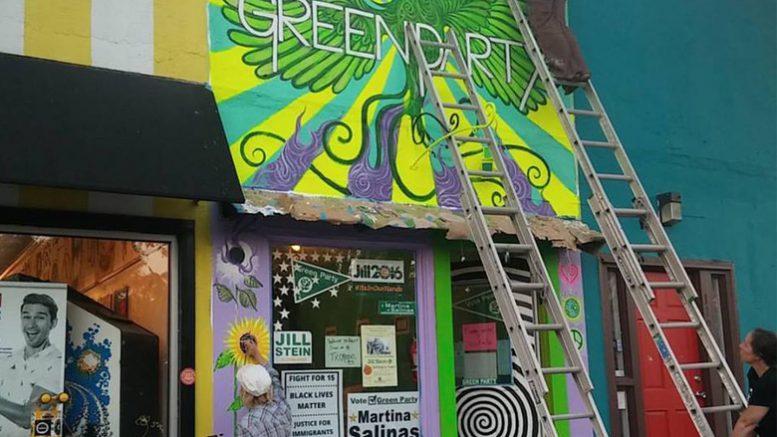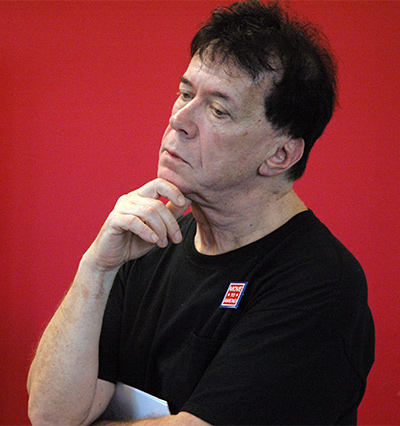By Christopher Casey
In a recent article for Truthdig, Chris Hedges reiterated what many of us on the Left have been saying for some time. The Bernie Sanders campaign will NOT bring about any fundamental change, and represents a tragic diversion of social justice energies into the Democratic Party, a place where progressive movements go to die. Hedges also has some very sharp words about the current state of my Green Party, saying it is “crippled by endemic factionalism and dysfunction”. While I think Hedges’ latter comments are inaccurate and hyperbolic, he is correct in suggesting that the Green Party in the United States has yet to become the political force we envision it to be. Indeed, there are some divisions within the Green Party, but to talk about “endemic factionalism and dysfunction” is to harken back to the in-fighting days of 2004 when Nader ran independently and Cobb became the GPUS nominee.
While there is always vibrant political disagreement within the Greens, there is a great deal of unanimity and collective focus at the present time. Are we small? Yes, indeedy. But that is as much about the exigencies of American history, and the aggressive dismantling of the Left by the elites over the past 50 years. We all know that in the heyday of the relatively small, funded-from-above Tea Party movement, the media would cover their every burp and bellow. The Greens and the Left in general have been systematically excluded from the national and local media, and this has had no small impact on our growth.
Despite all this, the spirit of Hedges’ critique of the Greens can hardly be dismissed as completely inaccurate. So what is wrong with the Greens and the Left in general? Are we tone deaf to Hedges’ clarion call for overthrowing the entire corrupt political order? Yet while Chris Hedges talks eloquently about being “in the streets” and “making a revolution”, he has yet to provide us with any kind of a road map of how to get there. In my years of political organizing, I have come to develop my own pre-digital GPS unit for Left praxis navigation, and I would like to share some of it here.
First, I think effective praxis means not putting most of our eggs in the “let’s get a real progressive elected” basket. Unfortunately, I do believe that, unless we decide as a party to modify our dominant electoral focus vis-à-vis political strategy, we will continue to flounder and remain predominantly white in our demographic, and frail in the kind of political power we have built. Let me be clear. I am not saying we should jettison our electoral efforts in any way, shape or form. But what I am saying is that they need to be organically connected to the kind of praxis that grows power in local communities. I have dubbed it “storefront socialism”, but it is hardly a novel idea. The Black Panthers (think free breakfast programs for children), Hezbollah, the Italian Communist Party and many other political organizations have known for some time that in order to build political capital, you need to become part of, and directly service, the communities in which you live.
To cut to the chase, I believe strongly that, in addition to ongoing union organizing (admittedly more than ever an uphill challenge in this economic and political era), we need to focus on real base-building in the community. The old fashioned Marxist economic contradictions are only going to worsen over the next two decades, and the Left needs to position itself so that it can play a critical role in addressing same. We need to stop wasting our energy every four years supporting capitalist politicians, and instead become more service-oriented by growing roots in the community, and engaging in real base building. But this also means that the Green Party needs to invest as much money and time in creating these community centers as we do in trying to get people elected.
The storefront socialism model I have been advocating for some time looks to develop community centers that address pressing social needs, such as the opiate epidemic tearing apart neighborhoods everywhere. Such storefronts would seek to provide food banking, referral counseling, mental health and substance abuse counseling, clothing assistance, housing aid, and even some basic health care services (if the proper medical volunteers can be garnered to participate). These community centers would also hopefully become gathering places where education (think the Mohawk Valley Freedom School), art, poetry, dance, and a host of other creative endeavors could be pursued. Rather than being run by one progressive political organization only (such as the Greens), I would assume they would frequently be operated by a coalition of progressive groups, like the Social Justice Center in Albany.
The world’s poor and the planet are running out of time. We have to stop being sucked into the black hole that is the Democrapublican Party’s electoral charade every four years, and get smart as a movement. But this means we ourselves in the Green Party have to temper our historical addiction to a largely electoral strategy, and begin to embrace an Occupy Katrina approach to building a movement. We need to listen to what Chris Hedges has to say, but we also need to develop a new road map for the revolution he is talking about, something he himself is clearly lacking as well. We need to grow a real revolution, but we must always remember that putting those seeds in the ground will not be completed overnight. Electoral fixes in the belly of capitalism and the American Empire, have been, and will continue to be, cosmetic band-aids on the face of the beast.
Working to service and assist those who have been marginalized by the system, those who have been victimized by the dog-eat-dog realities of capitalism, is the best way to build political capital and grow a movement. As the economic and social conditions worsen over the next few decades in the United States, and the palpable suffering of the average American increases with it, we would be offering another palliative option besides opiates or cable television. Dorothy Day called it “direct aid”, and the Catholic Worker Movement she built with it had a powerful and lasting impact on the communities they served. In the final analysis, it is not just about revolutionary praxis and overthrowing a corrupt and evil system. It is about doing what is desperately needed, what is consistently moral, and what is certifiably right.

